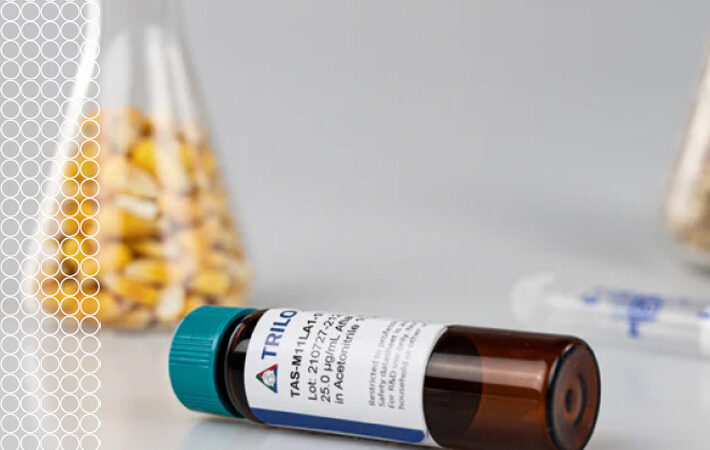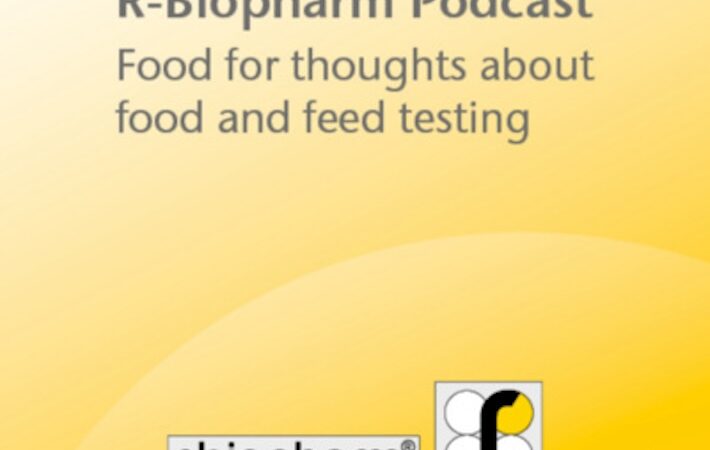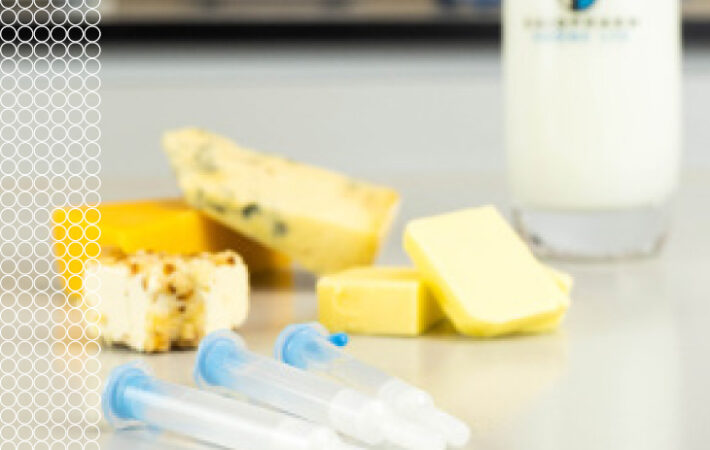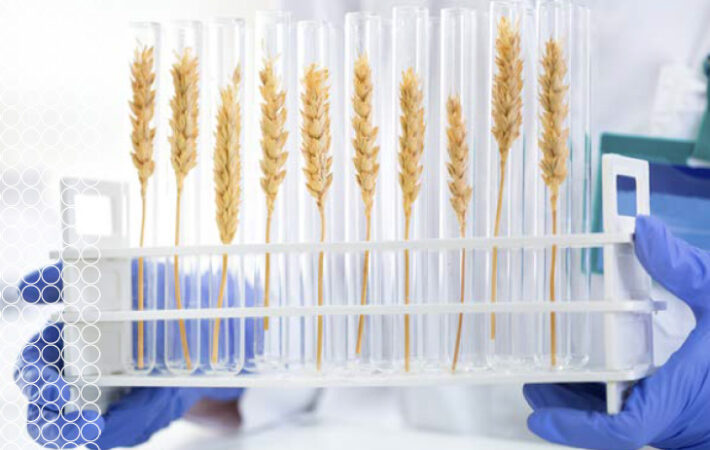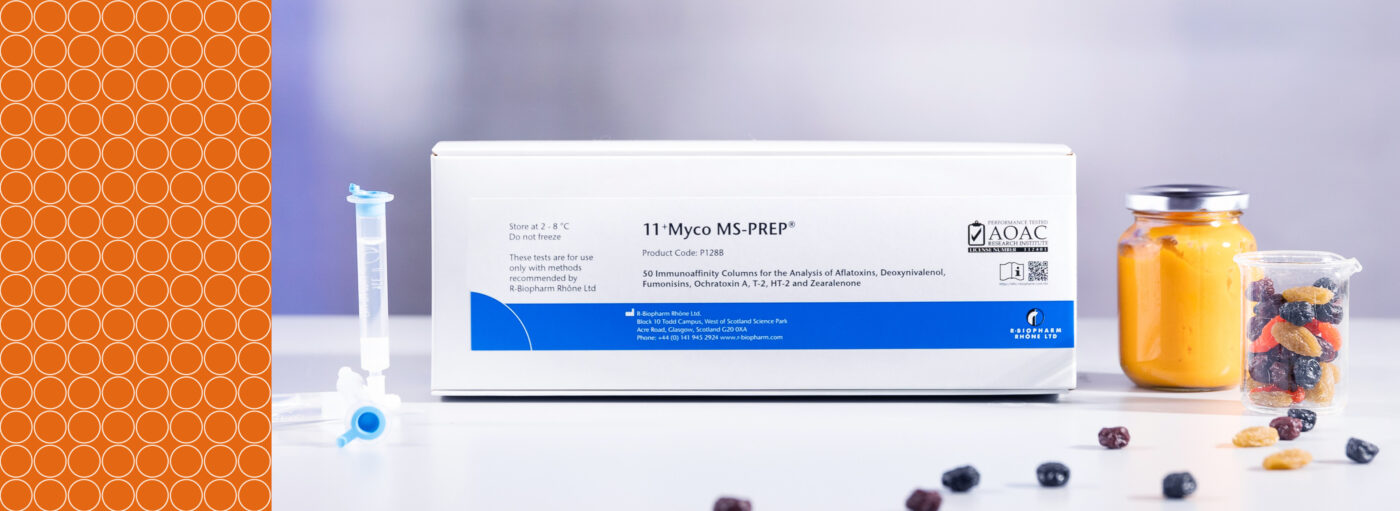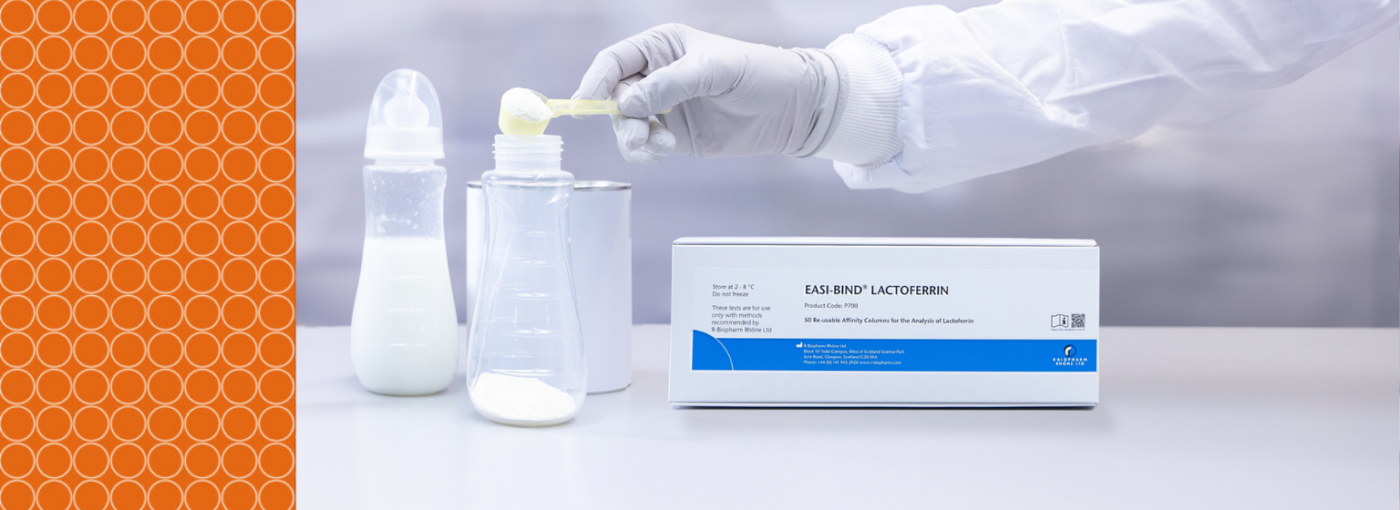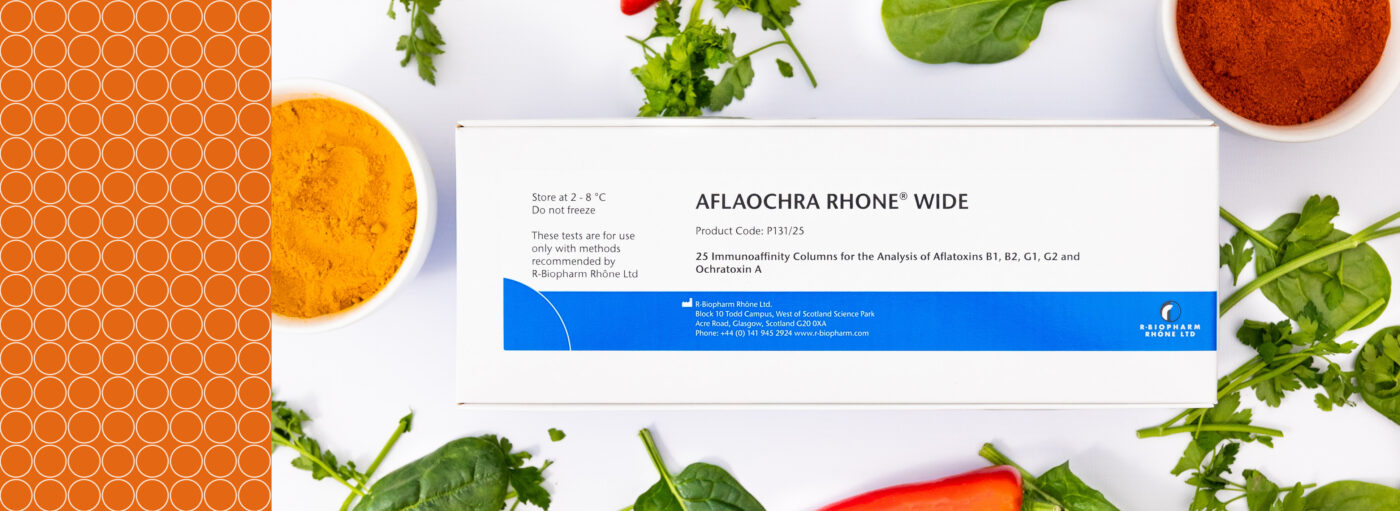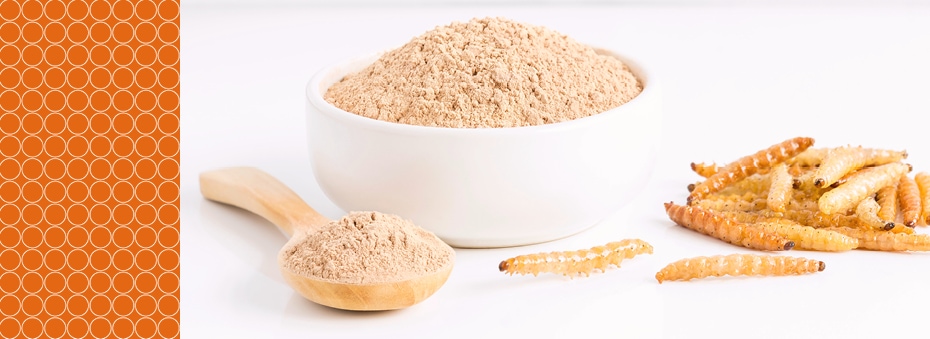
Mycotoxins
Mycotoxin analysis – rapid and reliable
Mycotoxins
Mycotoxins are toxic metabolites produced by molds. They can have serious acute and chronic effects on the health of humans as well as animals. Mycotoxin analysis of food and feed is therefore necessary and often required by legislation. Modern test kits allow rapid qualitative and quantitative analysis of mycotoxins.
Throughout history, mycotoxins (as we know them now) have impaired the quality of agricultural products. Major commodities such as corn, wheat, rice, soy and peanuts can be contaminated with mycotoxins, depending on growth conditions and storage conditions. So can other commodities like rye, oats, hazelnuts, figs, grapes or spices be affected by mycotoxins. The consumption of mycotoxin contaminated products may have acute toxic health effects on humans and animals as well as chronic effects. Besides health costs also direct economic factors play a role like decreased efficiency in the growth of farm animals, trade losses because of import and export limitations and direct losses in revenue of crop value. To protect the health of consumers and animals worldwide, legislations for mycotoxins are in place.
We offer test kits for all relevant mycotoxins from aflatoxin to zearalenone. Please choose a specific mycotoxin to find out more about it:
The smart way to test for mycotoxins
The RIDA®SMART APP allows for sensitive and high accurate measurements of quantitative R-Biopharm lateral flow strips.
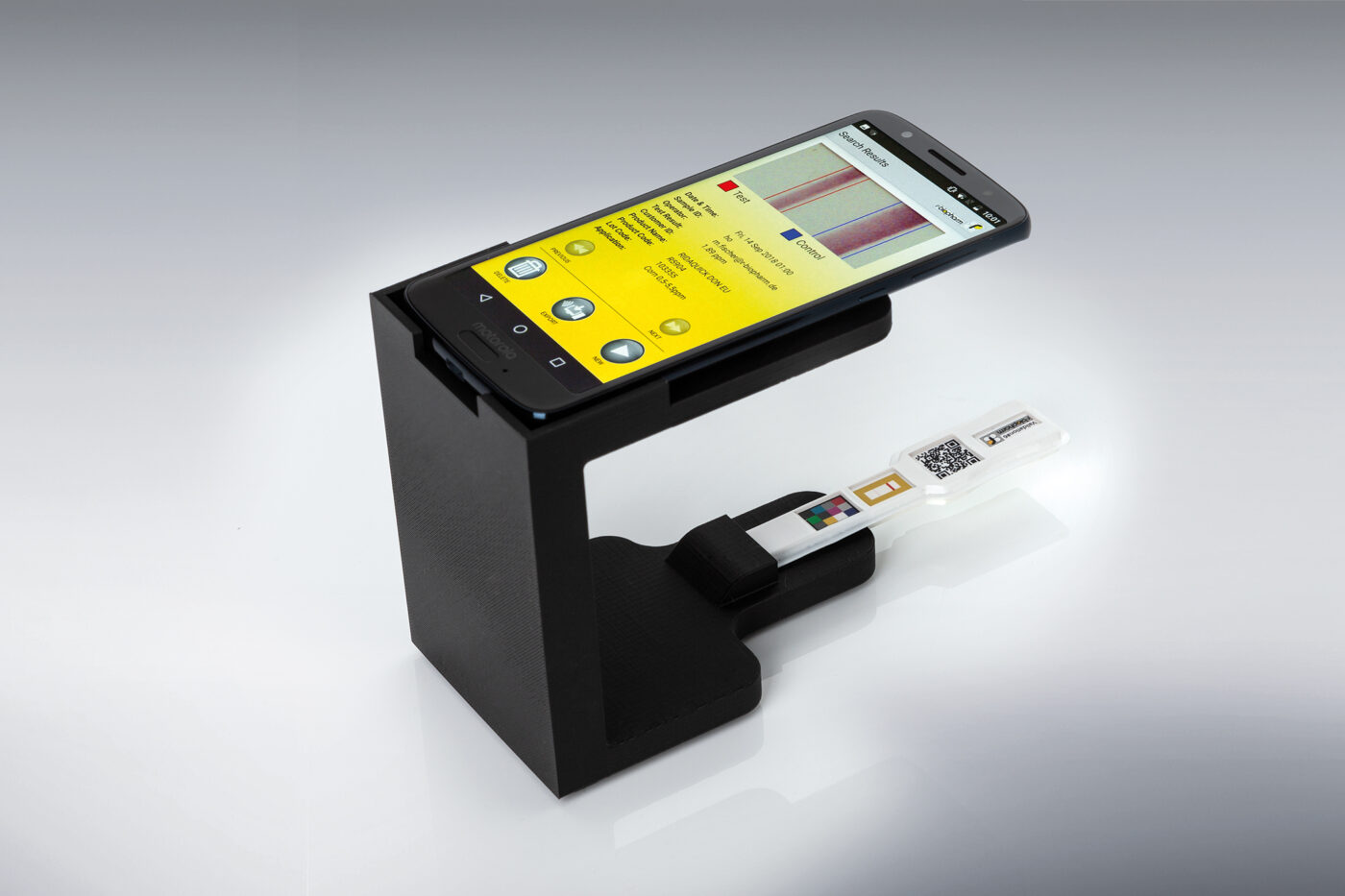
Methods for mycotoxin analysis
The analysis of mycotoxins presents some unique challenges: Mould fungus toxins are naturally occurring contaminants. Production prior to harvest is affected by weather conditions, as well as agricultural practices; production after harvest depends upon storage conditions. This puts certain challenges on the risk management of mycotoxins: Where, when, how often and how many do I test?
Mycotoxins are spread very inhomogeneously throughout a product and maybe present at very low levels. Samples to be tested may be analytically simple matrices such as wheat, corn or maybe very complicated matrices like spices, coffee or complex mixtures of ingredients as in animal feed. It is very important to choose the right sampling and analytical method for the product to be tested. R-Biopharm offers a wide range of analytical methods for mycotoxin analysis. Depending on matrix, number of samples, time to result, ease of use and available equipment, we can offer you the appropriate testing format:
ELISA (enzyme-linked immunosorbent assays) test kits are accurate and easy to use. ELISA test kits arethe ideal solution for a measurement of multiple samples. R-Biopharm offers two product lines for ELISA:
RIDASCREEN®FAST
Short incubation times of as low as 8 – 15 minutes, for mostly up to 19 samples in single determination in one run.
RIDASCREEN®
Low limit of detection (LOD). With incubation times of e.g. 75 minutes for up to 42 samples in double determination. Due to the longer incubation times these test kits can be automated using the e.g. ThunderBolt®.
The main advantages of ELISA are that it is fast for a high number of samples, low cost for set up and minimal training required. ELISA can be automated using the e.g. ThunderBolt®. Cost effectiveness for automation requires a minimum of 4 to 5 samples tested per ELISA run. Results are measured with an ELISA plate reader, such as the RIDA® Absorbance 96.
In general, testing of raw ingredients can be done with on-site rapid test. Results are available in minutes and require only a minimal amount of training and equipment. While conventional LFD kits use an organic solvent, more environmentallyfriendly kits use a water extraction to avoid organic solvent waste.
To remove subjectivity in the evaluation, digital reading of quantitative results is carried out with the RIDA®SMART APP.
The screening cards AFLACARD® and OCHRACARD® are specially designed to get a rapid, semi-quantitative result for more complex commodities.
Immunoaffinity columns (IAC) (e.g. RIDA®, EASI-EXTRACT®, PREP®, RHONE®) contain monoclonal antibodies making them highly selective. Further advantages are:
- Excellent sample clean-up, especially with complex commodities. This makes it possible to use solvent based standards with LC-MS/MS detection.
- Clean eluates mean that there is no requirement for matrix matched or isotopic labelled.
Solid phase extraction columns (SPE) use selected solid adsorbents to bind interfering components and pigments, allowing the mycotoxins to be easily analyzed. Further benefits are:
- Non-specific clean-up, making this an ideal clean-up tool for the analysis of multi-toxins in simple matrices like cereals.
- Simple, fast and cost-effective clean-up providing an excellent screening test in conjunction with LC-MS/MS.
- Can be used in combination with matrix matched standards removing the requirement for expensive isotopic labelled standards.
HPLC and LC-MS/MS are also reference methods if it comes to legal issues. The main advantages of High Performance Liquid Chromatography (HPLC) and LC-MS/MS are their high sensitivity, applicability to complex matrixes and accuracy. However, to obtain top-notch HPLC and LC-MS/MS performance, an optimized sample clean-up using solid phase or immunoaffinity columns are required.
For very high sample throughput, fully automated systems like CHRONECT Symbiosis RIDA®CREST using immunoaffinity cartridges can be used up to 15 times. With LC-MS/MS all regulated mycotoxins are detected as well as most common masked andemerging metabolites. It is also possible to analyse other parameters such as pesticides and veterinary drugs.
More information?
Our flyers are the ideal resource for clear and comprehensible product information. Get an overview of our analytical mycotoxin solutions.
Multi-mycotoxin analysis
Mycotoxins generally co-occur in different commodities. It is not unusual to find different trichothecenes in one product, sometimes even in combination with zearalenone. Other commodities might contain both aflatoxin and ochratoxin or aflatoxin and fumonisin. Multi-mycotoxin methods are able to detect multiple mycotoxins simultaneously. We offer solutions for an effective multi-mycotoxin clean-up prior to analysis with HPLC or LC-MS/MS.
Mycotoxin reference material
Mycotoxin testing imposes unique challenges to analytical laboratories. Complicated matrices, inhomogeneously spread contaminations, very low levels are just a few challenges to be met. The importance of choosing the right sample preparation and analytical method is obvious. The use of certified mycotoxin reference materials will strengthen your quality assurance in mycotoxin testing.
Mycotoxin standards
Mycotoxin standards solutions are used routinely in mycotoxin analysis. They can be used to prepare a calibration curve for the HPLC system, ensuring accurate determination of the toxin. The standard solution can also be used to spike samples in order to check the extraction efficiency of the toxin from certain foods using a particular solvent, or alternatively, to spike sample extracts.
Product portfolio
| Product | Description | No. of tests/amount | Art. No. |
|---|---|---|---|
| AFLACARD TOTAL |
A qualitative screening card for the detection of different aflatoxin total levels in food and feed samples. Read more |
10 cards containing 20 tests and controls | RBRP38 |
| AFLACARD B1 |
A qualitative screening card for detection of aflatoxin B1 at various levels in food and feed commodities. Read more |
10 cards containing 20 tests and controls | RBRP27 |
| OCHRACARD |
A qualitative screening card for detection of ochratoxin A at various levels in food and feed commodities. Read more |
10 cards containing 20 tests and controls | RBRP48 |
| Product | Description | No. of tests/amount | Art. No. |
|---|---|---|---|
| EuroProxima Ochratoxin A |
EuroProxima Ochratoxin A is a competitive enzyme immunoassay for quantitative analysis of ochratoxin A in corn, wheat, red wine, white wine, must, roasted coffee, instant coffee, green coffee, cocoa, figs and raisins. Read more |
Microtiter plate with 96 wells (12 strips with 8 wells each). | 5121OTA |
| EuroProxima Aflatoxin B1 sensitive |
EuroProxima Aflatoxin B1 sensitive is a competitive enzyme immunoassay for quantitative analysis of aflatoxin B1 in cereals, nuts, feed, infant food, liver, red pepper and serum. Read more |
Microtiter plate with 96 wells (12 strips with 8 wells each). | 5121AFBS |
| EuroProxima PLUS Aflatoxin M1 sensitive |
EuroProxima PLUS Aflatoxin M1 sensitive is a competitive enzyme immunoassay for quantitative analysis of aflatoxin M1 in milk, cheese, butter and infant formula. Read more |
Microtiter plate with 96 wells (12 strips with 8 wells each). | 5121AFMS |
| RIDASCREEN® Fumonisin ECO |
RIDASCREEN® Fumonisin ECO is a competitive enzyme immunoassay for the quantitative determination of fumonisin in corn and feed. Please note: it will replace the previous test kit RIDASCREEN® Fumonisin (Art. No. R3401) soon. Read more |
Microtiter plate with 96 wells (12 strips with 8 wells each) | R3411 |
| RIDASCREEN® Ochratoxin A 30/15 |
RIDASCREEN® Ochratoxin A 30/15 is a competitive enzyme immunoassay for the quantitative analysis of ochratoxin A in corn, wheat, barley, rye, rice and feed. Read more |
Microtiter plate with 96 wells (12 strips with 8 wells each). | R1312 |
| RIDASCREEN® T-2 / HT-2 Toxin |
RIDASCREEN® T-2 / HT-2 Toxin is a competitive enzyme immunoassay for the quantitative analysis of the sum of T-2 and HT-2 toxin in oats, corn (maize), barley and wheat. Read more |
Microtiter plate with 96 wells (12 strips with 8 wells each) | R3805 |
| RIDASCREEN® Zearalenon |
RIDASCREEN® Zearalenon is a competitive enzyme immunoassay for the quantitative analysis of zearalenone residues in cereals, feed, beer, serum and urine. Read more |
Microtiter plate with 96 wells (12 strips with 8 wells each). | R1401 |
| RIDASCREEN® DON |
RIDASCREEN® DON is a competitive enzyme immunoassay for the quantitative analysis of DON in cereals, malt, feed, beer and wort. Read more |
Microtiter plate with 96 wells (12 strips with 8 wells each) | R5906 |
| RIDASCREEN® T-2 Toxin |
RIDASCREEN® T-2 Toxin is a competitive enzyme immunoassay for the quantitative determination of T-2 toxin in cereals and feed. Read more |
Microtiter plate with 96 wells (12 strips with 8 wells each) | R3801 |
| RIDASCREEN®FAST Zearalenon SC |
RIDASCREEN®FAST Zearalenon SC is a competitive enzyme immunoassay for the quantitative analysis of zearalenone in cereals. Read more |
Microtiter plate with 48 wells (6 strips with 8 wells each) | R5505 |
| RIDASCREEN®FAST Zearalenon |
RIDASCREEN®FAST Zearalenon is a competitive enzyme immunoassay for the quantitative analysis of zearalenone in cereals and feed. The test was validated with different matrices of cereals and composed feed. Read more |
Microtiter plate with 48 wells (6 strips with 8 wells each) | R5502 |
| RIDASCREEN®FAST T-2 Toxin |
RIDASCREEN®FAST T-2 Toxin is a competitive enzyme immunoassay for the quantitative analysis of T-2 toxin in cereals and feed. Read more |
Microtiter plate with 48 wells (6 strips with 8 wells each) | R5302 |
| RIDASCREEN®FAST Ochratoxin A |
RIDASCREEN®FAST Ochratoxin A is a competitive enzyme immunoassay for the quantitative analysis of ochratoxin A in corn, wheat, barley, oats (grains) and feed. Read more |
Microtiter plate with 48 wells (6 strips with 8 wells each) | R5402 |
| RIDASCREEN®FAST DON SC |
RIDASCREEN®FAST DON SC is a competitive enzyme immunoassay for the quantitative determination of DON in cereals, malt and feed with a sinlge control standard curve. Read more |
Microtiter plate with 48 wells (6 strips with 8 wells each). | R5905 |
| RIDASCREEN®FAST DON |
RIDASCREEN®FAST DON is a competitive enzyme immunoassay for the quantitative analysis of DON in cereals, malt and feed. Read more |
R5901: microtiter plate with 96 wells (12 strips with 8 removable wells each) R5902: microtiter plate with 48 wells (6 strips with 8 removable wells each) |
R5901 / R5902 |
| RIDASCREEN®FAST Citrinin |
RIDASCREEN®FAST Citrinin assay is a competitive enzyme immunoassay for the quantitative determination of citrinin in cereals and feed. Read more |
Microtiter plate with 48 wells (6 strips with 8 wells each) | R6302 |
| RIDASCREEN®FAST Aflatoxin SC |
RIDASCREEN®FAST Aflatoxin SC is a competitive enzyme immunoassay for the quantitative analysis of aflatoxin in cereals and feed with a single control standard curve. Read more |
Microtiter plate with 48 wells (6 strips with 8 wells each) | R9002 |
| RIDASCREEN®FAST Aflatoxin |
RIDASCREEN®FAST Aflatoxin is a competitive enzyme immunoassay for the quantitative analysis of aflatoxin in cereals and feed. Read more |
Microtiter plate with 48 wells (6 strips with 8 wells each) | R5202 |
| RIDASCREEN® Aflatoxin Total |
RIDASCREEN® Aflatoxin Total is a competitive enzyme immunoassay for the quantitative determination of aflatoxins in cereals and feed. Read more |
Microtiter plate with 96 wells (12 strips with 8 wells each) | R4701 |
| RIDASCREEN® Aflatoxin B1 30/15 |
RIDASCREEN® Aflatoxin B1 30/15 is a competitive enzyme immunoassay for the quantitative determination of aflatoxin B1 in cereals and feed. Read more |
Microtiter plate with 96 wells (12 strips with 8 wells each) | R1211 |
| RIDASCREEN® Aflatoxin M1 |
RIDASCREEN® Aflatoxin M1 is a competitive enzyme immunoassay for the quantitative analysis of aflatoxin M1 in milk and milk powder. Read more |
Microtiter plate with 96 wells (12 strips with 8 wells each) | R1121 |
| RIDASCREEN®FAST Fumonisin ECO |
RIDASCREEN®FAST Fumonisin ECO is a competitive enzyme immunoassay for the quantitative determination of fumonisin in corn and feed. Read more |
Microtiter plate with 48 wells (6 strips with 8 removable wells each) | R5603 |
| Product | Description | No. of tests/amount | Art. No. |
|---|---|---|---|
| RIDA®QUICK Mycotoxin ECO Extractor |
Universal extraction buffer for RIDA®QUICK mycotoxin test kits. Read more |
110 mL (10x concentrate) | R5000 |
| RIDA®QUICK Ochratoxin ECO |
RIDA®QUICK Ochratoxin ECO is a quantitative immunochromatographic test in strip format for the quantitative determination of ochratoxin in corn and wheat. Results are evaluated with the RIDA®SMART APP software (Art. No. ZRSAM1000) and an approved … Read more |
20 x test strips | R5404 |
| RIDA®QUICK Aflatoxin RQS ECO |
RIDA®QUICK Aflatoxin RQS ECO is a quantitative immunochromatographic test in a test strip format to determine aflatoxin (sum B1, B2, G1, G2) in corn. The test uses an aqueous extraction method. Results are evaluated with the RIDA®SMART APP software … Read more |
20 x test strips | R5209 |
| RIDA®QUICK Aflatoxin RQS |
RIDA®QUICK Aflatoxin RQS is a quantitative immunochromatographic test in strip format for the determination of aflatoxin in corn. Results are evaluated with the RIDA®SMART APP software (Art. No. ZRSAM1000)and an approved smartphone or installed on … Read more |
20 x test strips | R5208 |
| RIDA®QUICK DON RQS ECO |
RIDA®QUICK DON RQS ECO is a quantitative immunochromatographic test with water extraction in a test strip format to determine DON in grains (wheat, corn, barley, oats). Results are evaluated with the RIDA®SMART APP software (Art. No. ZRSAM1000) and … Read more |
20 x test strips | R5911 |
| RIDA®QUICK T-2 / HT-2 RQS ECO |
RIDA®QUICK T-2 / HT-2 RQS ECO is a immunochromatographic test in strip format for the quantitative determination of the sum of T-2 / HT-2 toxin in oats, wheat and corn (maize). Results are evaluated with the RIDA®SMART APP software (Art. No. … Read more |
20 x test strips | R5304 |
| RIDA®QUICK Zearalenon RQS |
RIDA®QUICK Zearalenon RQS is a quantitative immunochromatographic test in strip format for the detemination of zearalenone in corn. Results are evaluated with the RIDA®SMART APP software (Art. No. ZRSAM1000) and an approved smartphone or installed … Read more |
20 x test strips | R5504 |
| RIDA®QUICK Fumonisin RQS ECO |
RIDA®QUICK Fumonisin RQS ECO is a quantitative immunochromatographic strip test with an aqueous extraction method for the detection of fumonisin in corn. Results are evaluated with the RIDA®SMART APP software (Art. No. ZRSAM1000) and an approved … Read more |
20 x test strips | R5606 |
| Product | Description | No. of tests/amount | Art. No. |
|---|---|---|---|
| QualiT Pure™ Multi-Ergot Alkaloid MS |
Solid phase clean-up column for the purification of multi-mycotoxins. Read more |
50 columns (syringe format) | TC-QP2100-50 |
| QualiT Pure™ Multi-Mycotoxin |
Solid phase clean-up column for the purification of multi-mycotoxins. Read more |
50 columns (syringe format) | TC-QP1000-50 |
| QualiT Pure™ Multi-tox MS |
Solid phase clean-up column for the purification of multi-mycotoxins. Read more |
50 columns (syringe format) | TC-QP1100-50 |
| IMMUNOPREP® ONLINE OCHRATOXIN |
Online immunoaffinity cartridges used in conjunction with the CHRONECT Symbiosis RIDA®CREST system for the automated clean-up and analysis of ochratoxin A prior to HPLC or LC-MS/MS. Read more |
RBRP901/48: 48 cartridges, RBRP901: 96 cartridges |
RBRP901 / RBRP901/48 |
| IMMUNOPREP® ONLINE AFLATOXIN M1 |
Online immunoaffinity cartridges used in conjunction with the CHRONECT Symbiosis RIDA®CREST system for the automated clean-up and analysis of aflatoxins M1 prior to HPLC or LC-MS/MS. Read more |
RBRP904/48: 48 cartridges | RBRP904/48 |
| IMMUNOPREP® ONLINE AFLATOXIN |
Online immunoaffinity cartridges used in conjunction with the CHRONECT Symbiosis RIDA®CREST system for the automated clean-up and analysis of aflatoxins B1, B2, G1 and G2 prior to HPLC or LC-MS/MS. Read more |
RBRP900/48: 48 cartridges, RBRP900: 96 cartridges |
RBRP900 / RBRP900/48 |
| 11⁺Myco MS-PREP® |
Multi-mycotoxin immunoaffinity columns for simultaneous detection of aflatoxins B1, B2, G1, G2, ochratoxin A, fumonisins B1 and B2, Deoxynivalenol, Zearalenone, T-2 and HT-2 in a wide range of commodities in conjunction with LC-MS/MS. Read more |
RBRP128: 10 immunoaffinity columns (3 ml format), RBRP128B: 50 immunoaffinity columns (3 ml format) |
RBRP128 / RBRP128B |
| EASI-EXTRACT® CITRININ |
Immunoaffinity columns for use in conjunction with an HPLC or LC-MS/MS for detection of citrinin in a wide range of commodities. Read more |
10 columns (3 ml format) (RBRDP126), 25 columns (3 ml format) (RBRP126) |
RBRDP126 / RBRP126 |
| AFLAPREP® M WIDE |
The procedure is based on monoclonal antibody technology, which makes the test highly specific, sensitive, rapid and simple to perform. Immunoaffinity columns for use in conjunction with an HPLC or LC-MS/MS for detection of aflatoxin M1 in milk and … Read more |
10 columns (3 ml format) (RBRP124), 50 columns (3 ml format) (RBRP124B) |
RBRP124 / RBRP124B |
| AOF MS-PREP® |
AOF MS-PREP® immunoaffinity columns contain highly specific monoclonal antibodies directed against aflatoxin, ochratoxin A and fumonisin. The columns lead not only to a clean-up of the sample but also to a selective purification of the mycotoxins. … Read more |
RBRP115: 10 immunoaffinity columns (3 ml format), RBRP115B: 50 immunoaffinity columns (3 ml format) |
RBRP115 / RBRP115B |
| OCHRAPREP® |
Immunoaffinity columns for use in conjunction with HPLC or LC-MS/MS for detection of ochratoxin A in a wide range of commodities. Read more |
10 columns (3 ml format) (RBRP14) 50 columns (3 ml format) (RBRP14B) 500 columns (3ml format) (RBRP14/500) |
RBRP14 / RBRP14B |
| EASI-EXTRACT® ZEARALENONE |
Immunoaffinity columns for use in conjunction with HPLC or LC-MS/MS for detection of zearalenone in a wide range of commodities. Read more |
10 columns (3 ml format) (RBRRP91), 50 columns (3 ml format) (RBRRP90) |
RBRRP91 / RBRRP90 |
| EASI-EXTRACT® T-2 and HT-2 |
Immunoaffinity columns for use in conjunction with an HPLC or LC-MS/MS for detection of T-2 and HT-2 toxins in a wide range of commodities. Read more |
10 columns (3 ml format) (RBRP43), 50 columns (3 ml format) (RBRP43B) |
RBRP43 / RBRP43B |
| EASIMIP™ PATULIN |
Molecularly Imprinted Polymer (MIP) columns for use in conjunction with an HPLC for detection of patulin in apple juice and apple purée. Read more |
RBRP250: 10 columns (3 ml format), RBRP250B: 50 columns (3 ml format) |
RBRP250 / RBRP250B |
| RIDA® Ochratoxin A column |
RIDA® Ochratoxin A column are immunoaffinity columns for sample clean up prior to analysis of Ochratoxin A in food and feed. Read more |
10 immunoaffinity columns | R1303 |
| AFLAOCHRA PREP® |
Multi-mycotoxin immunoaffinity columns for simultaneous detection of aflatoxins B1, B2, G1, G2 and ochratoxin A in a wide range of commodities in conjunction with HPLC or LC-MS/MS. Read more |
RBRP89: 10 immunoaffinity columns (1 ml format), RBRP89B: 50 immunoaffinity columns (1 ml format) |
RBRP89 / RBRP89B |
| DZT MS-PREP® |
DZT MS-PREP® immunoaffinity columns contain highly specific monoclonal antibodies directed against DON, zearalenone, T-2 and HT-2 toxin. The columns lead not only to a clean-up of the sample but also to a selective purification of the mycotoxins. … Read more |
RBRP73: 10 immunoaffinity columns (1 ml format), RBRP73B: 50 immunoaffinity columns (1 ml format) |
RBRP73 / RBRP73B |
| AO ZON PREP® |
Multi-mycotoxin immunoaffinity columns for simultaneous detection of aflatoxins B1, B2, G1, G2, ochratoxin A and zearalenone in a wide range of commodities in conjunction with HPLC or LC-MS/MS. Read more |
RBRP112: 10 immunoaffinity columns (3 ml format), RBRP112B: 50 immunoaffinity columns (3 ml format) |
RBRP112 / RBRP112B |
| FUMONIPREP® |
Immunoaffinity columns are used in conjunction with HPLC or LC-MS/MS for detection of fumonisins B1 and B2 in a wide range of commodities. Read more |
10 columns (3 ml format) (RBRDP31), 50 columns (3 ml format) (RBRP31B) |
RBRDP31 / RBRP31B |
| DONPREP® |
Immunoaffinity columns for use in conjunction with an HPLC or LC-MS/MS for detection of deoxynivalenol in a wide range of commodities. Read more |
10 columns (3 ml format) (RBRP50) 50 columns (3 ml format) (RBRP50B) |
RBRP50 / RBRP50B |
| EASI-EXTRACT® AFLATOXIN |
Immunoaffinity columns for use in conjunction with an HPLC or LC-MS/MS for detection of aflatoxins B1, B2, G1, G2, M1 and M2 in a wide range of commodities. Read more |
10 columns (3 ml format) (RBRRP71) 50 columns (3 ml format) (RBRRP70N) 500 columns (3 ml format) (RBRP70N/500) |
RBRRP71 / RBRRP70N |
| RIDA® Aflatoxin column |
RIDA® Aflatoxin columns (Art. No. R5001/R5002) are immunoaffinity columns for sample clean up prior to analysis of aflatoxins B1, B2, G1, G2 in food and feed. The columns are particularly suited for the clean up of difficult sampIes such as nuts, … Read more |
10 immunoaffinity columns (1 ml format) (R5001), 50 immunoaffinity columns (1 ml format) (R5002) |
R5001 / R5002 |
| PuriTox Aflatoxin |
Solid phase clean-up columns for the purification of aflatoxins B1, B2, G1 and G2 from peanuts. Read more |
50 columns (syringe format) | RBRP25 |
| AFLAPREP® |
The procedure is based on monoclonal antibody technology, which makes the test highly specific, sensitive, rapid and simple to perform. Read more |
10 columns (1 ml format) (RBRDP07) 50 columns (1 ml format) (RBRP07) 500 columns ( 1ml format) (RBRP07/500) |
RBRDP07 / RBRP07 |
| PuriTox AflaZON |
Solid phase clean-up columns for the purification of aflatoxins and zearalenone from cereals. Read more |
25 solid phase clean-up columns (syringe format) | TC-M160 |

